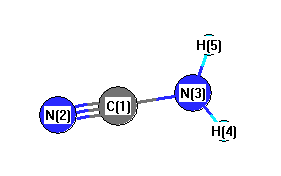Jump to
S1C2
Vibrational Frequencies calculated at SVWN/6-311G*
Geometric Data calculated at SVWN/6-311G*
Electronic energy levels
Charges, Dipole, Quadrupole and Polarizability
Jump to
S1C1
Energy calculated at SVWN/6-311G*
| | hartrees |
|---|
| Energy at 0K | -148.006856 |
| Energy at 298.15K | |
| HF Energy | -148.006856 |
| Nuclear repulsion energy | 59.539401 |
The energy at 298.15K was derived from the energy at 0K
and an integrated heat capacity that used the calculated vibrational frequencies.
Vibrational Frequencies calculated at SVWN/6-311G*
| Mode Number |
Symmetry |
Frequency
(cm-1) |
Scaled Frequency
(cm-1) |
IR Intensities
(km mol-1) |
Raman Act
(Å4/u) |
Dep P |
Dep U |
|---|
| 1 |
A1 |
3533 |
3499 |
63.46 |
|
|
|
| 2 |
A1 |
2342 |
2320 |
118.25 |
|
|
|
| 3 |
A1 |
1584 |
1568 |
69.33 |
|
|
|
| 4 |
A1 |
1146 |
1135 |
7.00 |
|
|
|
| 5 |
B1 |
538 |
533 |
0.72 |
|
|
|
| 6 |
B1 |
294i |
291i |
330.70 |
|
|
|
| 7 |
B2 |
3638 |
3603 |
89.66 |
|
|
|
| 8 |
B2 |
1109 |
1098 |
6.52 |
|
|
|
| 9 |
B2 |
410 |
406 |
0.59 |
|
|
|
Unscaled Zero Point Vibrational Energy (zpe) 7002.1 cm
-1
Scaled (by 0.9904) Zero Point Vibrational Energy (zpe) 6934.9 cm
-1
See section
III.C.1 List or set vibrational scaling factors
to change the scale factors used here.
See section
III.C.2
Calculate a vibrational scaling factor for a given set of molecules
to determine the least squares best scaling factor.
Geometric Data calculated at SVWN/6-311G*
Point Group is C2v
Cartesians (Å)
| Atom |
x (Å) |
y (Å) |
z (Å) |
|---|
| C1 |
0.000 |
0.000 |
0.215 |
| N2 |
0.000 |
0.000 |
1.379 |
| N3 |
0.000 |
0.000 |
-1.101 |
| H4 |
0.000 |
0.872 |
-1.620 |
| H5 |
0.000 |
-0.872 |
-1.620 |
Atom - Atom Distances (Å)
| |
C1 |
N2 |
N3 |
H4 |
H5 |
| C1 | | 1.1640 | 1.3162 | 2.0316 | 2.0316 |
N2 | 1.1640 | | 2.4802 | 3.1233 | 3.1233 | N3 | 1.3162 | 2.4802 | | 1.0144 | 1.0144 | H4 | 2.0316 | 3.1233 | 1.0144 | | 1.7431 | H5 | 2.0316 | 3.1233 | 1.0144 | 1.7431 | |
 More geometry information
More geometry information
Calculated Bond Angles
| atom1 |
atom2 |
atom3 |
angle |
|
atom1 |
atom2 |
atom3 |
angle |
| C1 |
N3 |
H4 |
120.772 |
|
C1 |
N3 |
H5 |
120.772 |
| N2 |
C1 |
N3 |
180.000 |
|
H4 |
N3 |
H5 |
118.456 |
Electronic energy levels
Charges, Dipole, Quadrupole and Polarizability
Charges from optimized geometry at SVWN/6-311G*
Charges (e)
| Number |
Element |
Mulliken |
CHELPG |
AIM |
ESP |
| 1 |
C |
0.288 |
|
|
|
| 2 |
N |
-0.270 |
|
|
|
| 3 |
N |
-0.809 |
|
|
|
| 4 |
H |
0.396 |
|
|
|
| 5 |
H |
0.396 |
|
|
|
Electric dipole moments
Electric dipole components in Debye
(What's a Debye? See section
VII.A.3)
| |
x |
y |
z |
Total |
| |
0.000 |
0.000 |
-4.979 |
4.979 |
| CHELPG |
|
|
|
|
| AIM |
|
|
|
|
| ESP |
|
|
|
|
Electric Quadrupole moment
Quadrupole components in D Å
| Primitive |
|---|
| | x | y | z |
|---|
| x |
-18.736 |
0.000 |
0.000 |
| y |
0.000 |
-14.646 |
0.000 |
| z |
0.000 |
0.000 |
-17.433 |
|
| Traceless |
|---|
| | x | y | z |
|---|
| x |
-2.697 |
0.000 |
0.000 |
| y |
0.000 |
3.439 |
0.000 |
| z |
0.000 |
0.000 |
-0.742 |
|
| Polar |
|---|
| 3z2-r2 | -1.484 |
|---|
| x2-y2 | -4.091 |
|---|
| xy | 0.000 |
|---|
| xz | 0.000 |
|---|
| yz | 0.000 |
|---|
|
Polarizabilities
Components of the polarizability tensor.
Units are
Å
3 (Angstrom cubed)
Change units.
| |
x |
y |
z |
| x |
1.801 |
0.000 |
0.000 |
| y |
0.000 |
2.198 |
0.000 |
| z |
0.000 |
0.000 |
5.055 |
<r2> (average value of r
2) Å
2
| <r2> |
39.426 |
| (<r2>)1/2 |
6.279 |
